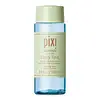What's inside
What's inside
 Key Ingredients
Key Ingredients

No key ingredients
 Benefits
Benefits

 Concerns
Concerns

 Ingredients Side-by-side
Ingredients Side-by-side

Water
Skin ConditioningAloe Barbadensis Leaf Juice
Skin ConditioningPropanediol
SolventGlycerin
HumectantSodium PCA
HumectantBetaine
HumectantLactobacillus Ferment Lysate Filtrate
Skin ConditioningGlycolic Acid
BufferingSodium Hyaluronate
HumectantSalicylic Acid
MaskingGlycyrrhiza Glabra Root Extract
BleachingSalix Alba Bark Extract
AstringentMagnesium Ascorbyl Phosphate
AntioxidantCentella Asiatica Extract
CleansingSaccharum Officinarum Extract
MoisturisingLeuconostoc/Radish Root Ferment Filtrate
AntimicrobialPopulus Tremuloides Bark Extract
AntiseborrhoeicLactic Acid
BufferingSodium Citrate
BufferingSodium Hydroxide
BufferingEthylhexylglycerin
Skin ConditioningCitric Acid
BufferingPotassium Sorbate
PreservativeSodium Benzoate
MaskingPhenoxyethanol
PreservativeWater, Aloe Barbadensis Leaf Juice, Propanediol, Glycerin, Sodium PCA, Betaine, Lactobacillus Ferment Lysate Filtrate, Glycolic Acid, Sodium Hyaluronate, Salicylic Acid, Glycyrrhiza Glabra Root Extract, Salix Alba Bark Extract, Magnesium Ascorbyl Phosphate, Centella Asiatica Extract, Saccharum Officinarum Extract, Leuconostoc/Radish Root Ferment Filtrate, Populus Tremuloides Bark Extract, Lactic Acid, Sodium Citrate, Sodium Hydroxide, Ethylhexylglycerin, Citric Acid, Potassium Sorbate, Sodium Benzoate, Phenoxyethanol
 Reviews
Reviews

Ingredients Explained
These ingredients are found in both products.
Ingredients higher up in an ingredient list are typically present in a larger amount.
Glycerin is already naturally found in your skin. It helps moisturize and protect your skin.
A study from 2016 found glycerin to be more effective as a humectant than AHAs and hyaluronic acid.
As a humectant, it helps the skin stay hydrated by pulling moisture to your skin. The low molecular weight of glycerin allows it to pull moisture into the deeper layers of your skin.
Hydrated skin improves your skin barrier; Your skin barrier helps protect against irritants and bacteria.
Glycerin has also been found to have antimicrobial and antiviral properties. Due to these properties, glycerin is often used in wound and burn treatments.
In cosmetics, glycerin is usually derived from plants such as soybean or palm. However, it can also be sourced from animals, such as tallow or animal fat.
This ingredient is organic, colorless, odorless, and non-toxic.
Glycerin is the name for this ingredient in American English. British English uses Glycerol/Glycerine.
Learn more about GlycerinWater. It's the most common cosmetic ingredient of all. You'll usually see it at the top of ingredient lists, meaning that it makes up the largest part of the product.
So why is it so popular? Water most often acts as a solvent - this means that it helps dissolve other ingredients into the formulation.
You'll also recognize water as that liquid we all need to stay alive. If you see this, drink a glass of water. Stay hydrated!
Learn more about Water